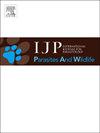阿伏唑胺(NexGard®)在一组人工饲养的蜥蜴中治疗和控制螨病的有效性和安全性
IF 2
3区 医学
Q3 ECOLOGY
International Journal for Parasitology-Parasites and Wildlife
Pub Date : 2025-06-15
DOI:10.1016/j.ijppaw.2025.101103
引用次数: 0
摘要
蜥蜴和其他爬行动物作为宠物在全世界越来越受欢迎。这些动物通常可能被一些螨类(如蛇螨)寄生,这些螨类是有害的,也因为它们是病原体(包括人畜共患病原体)的媒介。治疗选择是有限的,可能不是完全解决或安全的。本研究的目的是评估阿伏olaner (NexGard®;勃林格殷格翰(Boehringer Ingelheim,德国)在意大利南部的一个动物园里,将一群被螨虫感染的圈养蜥蜴与其他爬行类混合饲养在一起。对蜥蜴进行临床检查和称重,并对动物及其围栏(环境)内的螨虫感染情况进行评估。所有动物均口服每公斤体重2.5 mg阿伏唑啉(2.5 mg/kg)。所有动物在治疗前(T0)和治疗后不同时间点(T1, 24 h;T2, 14天;T3, 28天)。采集到的螨在种水平上进行了形态鉴定,并在分子和系统发育上证实了种的身份。对动物进行了血液寄生虫、体内寄生虫和媒介传播病原体的形态分子筛选。总的来说,筛选了28只蜥蜴,并在苏丹镀蜥蜴中检测到幼利什曼原虫。此外,6只(21.4%)蜥蜴至少有一只螨。螨类鉴定为寄生于印度尼西亚蓝舌石龙子和粗尾岩石龙子的两种螨类:O. natricis和Pterygosoma inermis。T1后寄主身上未见螨类,T3时环境中未见螨类。在接受治疗的蜥蜴中没有观察到副作用。单次口服2.5 mg/kg剂量的阿伏唑啉对蜥蜴是一种安全的治疗方法,对治疗和预防常见螨种的侵害100%有效。本文章由计算机程序翻译,如有差异,请以英文原文为准。

Efficacy and safety of afoxolaner (NexGard®) in a collection of captive-bred lizards for the treatment and control of mite infestation
Lizards and other reptiles are increasingly gaining popularity as pets worldwide. These animals may be commonly parasitized by species of mites such as Ophionyssus natricis, which are deleterious, also because of their role as vectors of pathogens, including zoonotic ones. Treatment options are limited and may not be completely resolutive or safe. The aim of the present study was to assess the efficacy of afoxolaner (NexGard®; Boehringer Ingelheim, Germany) in a collection of mite-infested captive-bred lizards that were housed in mixed enclosures with other reptile classes, in a zoological park located in southern Italy. Lizards were clinically examined and weighed, and mite infestations were assessed on the animals and in their enclosures (environment). All animals were treated with a dose of 2.5 mg afoxolaner per kilogram body weight (2.5 mg/kg) administered orally. All animals were examined pre-treatment (T0) and at various time points post-treatment (T1, 24 h; T2, 14 days; T3, 28 days). The collected mites were morphologically identified at the species level and the species identity also confirmed molecularly and phylogenetically. Animals were morpho-molecularly screened for hemoparasites, endoparasites and vector-borne pathogens. Overall, 28 lizards were screened, and Leishmania infantum was detected in a Sudan plated lizard. Moreover, 6 (21.4 %) lizards had at least one mite. Mites were identified as O. natricis and Pterygosoma inermis infesting Indonesian blue-tongued skinks and Roughtail rock agamas, respectively. No mites were found on hosts after T1, and at T3 no mites were observed in the environment. No side effects were observed in the treated lizards. A single oral administration of afoxolaner at 2.5 mg/kg was a safe treatment in lizards and 100 % effective for the treatment and prevention of common mite species infestations.
求助全文
通过发布文献求助,成功后即可免费获取论文全文。
去求助
来源期刊

International Journal for Parasitology-Parasites and Wildlife
Medicine-Infectious Diseases
CiteScore
3.80
自引率
5.60%
发文量
113
审稿时长
45 days
期刊介绍:
The International Journal for Parasitology: Parasites and Wildlife (IJP-PAW) publishes the results of original research on parasites of all wildlife, invertebrate and vertebrate. This includes free-ranging, wild populations, as well as captive wildlife, semi-domesticated species (e.g. reindeer) and farmed populations of recently domesticated or wild-captured species (e.g. cultured fishes). Articles on all aspects of wildlife parasitology are welcomed including taxonomy, biodiversity and distribution, ecology and epidemiology, population biology and host-parasite relationships. The impact of parasites on the health and conservation of wildlife is seen as an important area covered by the journal especially the potential role of environmental factors, for example climate. Also important to the journal is ''one health'' and the nature of interactions between wildlife, people and domestic animals, including disease emergence and zoonoses.
 求助内容:
求助内容: 应助结果提醒方式:
应助结果提醒方式:


